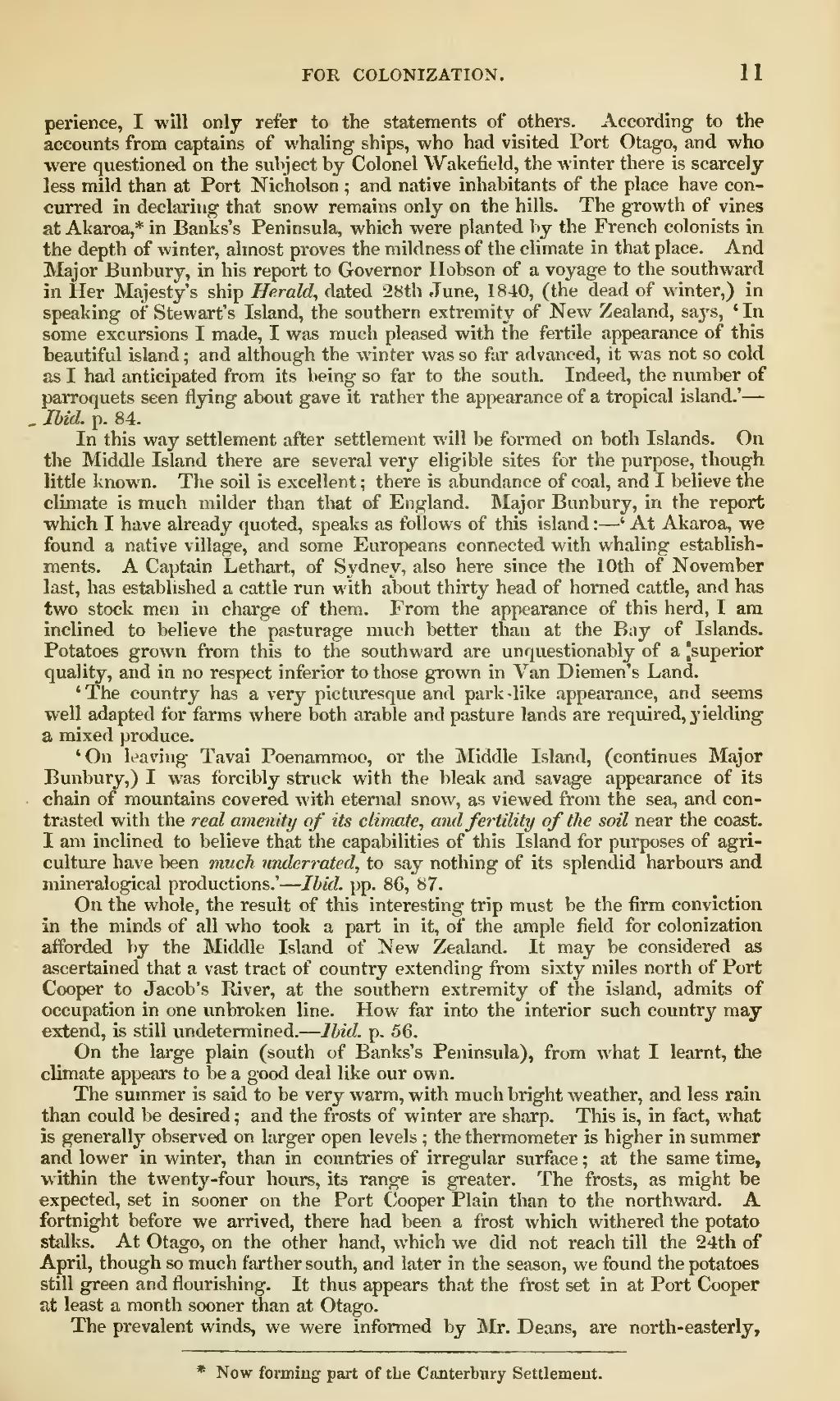perience, I will only refer to the statements of others. According to the accounts from captains of whaling ships, who had visited Port Otago, and who were questioned on the subject by Colonel Wakefield, the winter there is scarcely less mild than at Port Nicholson; and native inhabitants of the place have concurred in declaring that snow remains only on the hills. The growth of vines at Akaroa,[1] in Banks's Peninsula, which were planted by the French colonists in the depth of winter, almost proves the mildness of the climate in that place. And Major Bunbury, in his report to Governor Hobson of a voyage to the southward in Her Majesty's ship Herald, dated 28th June, 1840, (the dead of winter,) in speaking of Stewart's Island, the southern extremity of New Zealand, says, 'In some excursions I made, I was much pleased with the fertile appearance of this beautiful island; and although the winter was so far advanced, it was not so cold as I had anticipated from its being so far to the south. Indeed, the number of parroquets seen flying about gave it rather the appearance of a tropical island.'—Ibid. p. 84.
In this way settlement after settlement will be formed on both Islands. On the Middle Island there are several very eligible sites for the purpose, though little known. The soil is excellent; there is abundance of coal, and I believe the climate is much milder than that of England. Major Bunbury, in the report which I have already quoted, speaks as follows of this island:—'At Akaroa, we found a native village, and some Europeans connected with whaling establishments. A Captain Lethart, of Sydney, also here since the 10th of November last, has established a cattle run with about thirty head of horned cattle, and has two stock men in charge of them. From the appearance of this herd, I am inclined to believe the pasturage much better than at the Bay of Islands. Potatoes grown from this to the southward are unquestionably of a superior quality, and in no respect inferior to those grown in Van Diemen's Land.
'The country has a very picturesque and park like appearance, and seems well adapted for farms where both arable and pasture lands are required, yielding a mixed produce.
'On leaving Tavai Poenammoo, or the Middle Island, (continues Major Bunbury,) I was forcibly struck with the bleak and savage appearance of its chain of mountains covered with eternal snow, as viewed from the sea, and contrasted with the real amenity of its climate, and fertility of the soil near the coast. I am inclined to believe that the capabilities of this Island for purposes of agriculture have been much underrated, to say nothing of its splendid harbours and mineralogical productions.'—Ibid. pp. 86, 87.
On the whole, the result of this interesting trip must be the firm conviction in the minds of all who took a part in it, of the ample field for colonization afforded by the Middle Island of New Zealand. It may be considered as ascertained that a vast tract of country extending from sixty miles north of Port Cooper to Jacob's River, at the southern extremity of the island, admits of occupation in one unbroken line. How far into the interior such country may extend, is still undetermined.—Ibid. p. 56.
On the large plain (south of Banks's Peninsula), from what I learnt, the climate appears to be a good deal like our own.
The summer is said to be very warm, with much bright weather, and less rain than could be desired; and the frosts of winter are sharp. This is, in fact, what is generally observed on larger open levels; the thermometer is higher in summer and lower in winter, than in countries of irregular surface; at the same time, within the twenty-four hours, its range is greater. The frosts, as might be expected, set in sooner on the Port Cooper Plain than to the northward. A fortnight before we arrived, there had been a frost which withered the potato stalks. At Otago, on the other hand, which we did not reach till the 24th of April, though so much farther south, and later in the season, we found the potatoes still green and flourishing. It thus appears that the frost set in at Port Cooper at least a month sooner than at Otago.
The prevalent winds, we were informed by Mr. Deans, are north-easterly.
- ↑ Now forming part of the Canterbury Settlement
